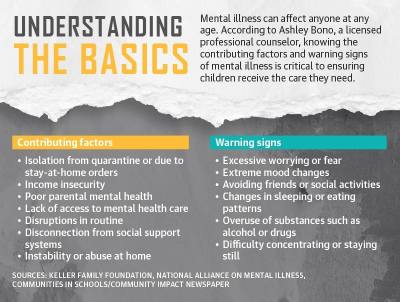“In a functional family, a lot of them just became closer through the pandemic,” Esquivel said. “However, for other families where there’s domestic violence, child abuse, drug and alcohol issues, now those kids didn’t have any escape from that.”
In 2021, about 37% of high school students reported that they experienced poor mental health during the COVID-19 pandemic. About 44% reported feeling persistently sad or hopeless, an 8% rise from 2019, according to data from the Centers for Disease Control and Prevention.
The CDC also reported a 24% increase in mental health-related emergency department visits during 2020 in those 5-11 years old and a 31% increase in those 12-17 years old. In line with the nationwide trend of emergency department visits, Communities in Schools of Central Texas—a local branch of the nationwide nonprofit aimed at supporting students through various resource outlets—also reported a higher number of students at risk for suicide or self harm needing intervention during the 2019-20 school year.
Though the number of students in need of intervention decreased between the 2020-21 and 2021-22 school years, the number of mental health and supportive guidance hours fluctuated.
“Mental health is individuals who are in crisis or have severe mental health needs. Guidance and counseling can be a lighter touch than the intense mental health, so it’s talking about setting goals, talking to someone about how to self-regulate, providing technique and tools,” said Sharon Vigil, CIS chief operations and equity officer. “It’s all connected.”
Persistent challenges
Mental health and emotional well-being play a role in a person’s overall health, according to the CDC. Social distancing, virtual learning and other pandemic safety measures made it difficult for teenagers and children to form social relationships and work on their social skills that contribute to their overall emotional well-being, Esquivel said.
“A lot of these children are behind now. Especially with the younger ones that were not in school. ... They have not had the opportunity to go and be with friends, make friends. ... How to negotiate, how to cooperate, how to share, how to borrow, how to talk to somebody, how to engage them in a conversation,” Esquivel said.
While academic slide has been discussed in pandemic-centric conversations, there also needs to be emotional slide conversations as well, Vigil said.
“We have an entire generation of students who lost the opportunity for socialization,” Vigil said, adding that lack of socialization is causing anxiety and social fatigue.
These issues are still on the mental health spectrum as it caters to a variety of needs, Vigil said.
“There are individuals who are in crisis who need mental crisis health support, and there are individuals who are having self-esteem issues or maybe eating disorders who also need mental health,” Vigil said.
The return to in-person instruction also brought about a slew of mental health needs in students, said Maritza Gonzalez, director of Guidance, Counseling and College & Career Readiness for Hays CISD.
Within the counseling department of HCISD, staffers focus on the social and emotional needs of a student to ensure they are set up for success and can succeed academically as well, she said.
The mental health challenges that children, teenagers and their families faced as a result of the pandemic led several organizations, including the American Academy of Pediatrics, to declare a national state of emergency in October.
There have been soaring rates of depression, anxiety, trauma and other issues that will have lasting impacts on young people, according to the declaration. Local, state and national resources must be utilized to improve access and quality of care, according to the academy.
Providing accessibility
As the needs of students have increased, HCISD is working toward being more proactive, not just reactive, via Lightspeed Systems, Gonzalez said. Lightspeed technology monitors students online connected through their school Google account and flags any concerning internet behavior.
Gonzalez said the data found is alarming, and the district hired an additional social worker solely to monitor alerts and identify students who may be at a critical point.
Within San Marcos CISD, ensuring a student feels safe is the No. 1 priority, said April Chatmon, director of social emotional learning and guidance for the district.
“That’s always the No. 1 priority from meeting basic needs all the way to providing those mental health supports and continuing to look for ways to close gaps for students,” Chatmon said.
For Chatmon, a big factor in mental health struggles is simply the language and stigma associated with them.
“One of the things that we talk about constantly is that stigma that centers around having to own the fact that there’s some type of mental health issue happening in your life,” she said.
The stigma surrounding mental health can become a barrier for someone seeking treatment, according to the American Psychological Association. Being conscious of the language and words used can be one of the many ways to address the stigma.
“It’s not unique to our community. You’ll hear [someone say], ‘I’m so OCD,’ when it’s not really OCD, [they] just like things to be neat,” Chatmon said. “[They are] not really using the right language to describe what’s happening. The stigma and the language of how we describe what’s happening has created some potential barriers.”
A barrier that CIS is trying to help districts overcome is socioeconomic disadvantage by providing On-Campus Student Support to campuses within Hays and San Marcos CISDs that have the highest-need students or campuses with high low socioeconomic disadvantage.
The American Psychological Association found that socioeconomic disadvantages are a significant contributing factor to mental health difficulties among ethnic and racial minority youth. External factors such as a poor quality education; unsafe neighborhoods; and experiences of racism, discrimination and oppression destabilize networks and structures that are meant to support children, which directly affect their mental health. CIS provides 23 full-time staffers to campuses across Hays and San Marcos CISDs, the services of which are cost shared between CIS and the districts.
Campuses, teachers and even counselors often do not have the time, capacity or skill set to provide counseling to all students, Vigil said.
The recommended student-to-counselor ratio, according to the American School Counselor Association, is 250:1 though the national average is closer to 415:1. The HCISD ratio is about 240:1 while the SMCISD ratio is 370:1.
Though the ratios are close to the recommended average, Gonzalez said they are still limited with resources at times, which is where CIS can help bridge the gap to resources and accessibility.
“CIS works alongside counselors, administrators, teachers and the community to bring resources and to bring highly trained individuals to campus,” Vigil said. “Our work is relation based. So what we do is we build a relationship with students and families.”
The Student Supports Model utilized by CIS consists of one staffer on campus, and they provide partially direct service but also have access to a network of partnerships that help provide assistance to students.
“One person cannot do the level of work that is needed, so our model really, really is founded on partnership work,” Vigil said.
She added that CIS of Central Texas is working to provide more access and overcome the barrier of transportation by creating a mental health unit made up of four individuals that will be able to travel to different campuses and districts to help students.
Addressing minority group disparities
Another barrier that CIS works to overcome is combating issues that plague Black, indigenous and other minority and LGBTQ communities.
“People are not seeing themselves in the work, in those who can help and can provide support,” Vigil said. “Nationally, the majority of the social workers are white, middle-class females. If you’re looking at our population, our students are predominantly black and brown.”
Through its partnerships, it can also reach the LGBTQ community. One of the partnerships CIS has is with Out Youth, a nonprofit organization dedicated to providing a safe space and counseling to LGBTQ youth and adults. “Not one person can be an expert at everything, so we look at the needs of the students on the campus and then bring in partnerships that way,” Vigil said. “We believe that mental health, guidance counseling [and] enrichment lead to high-quality education, and we believe that education is the golden ticket.”
Lauren Canterberry contributed to this report.







